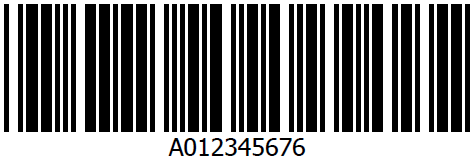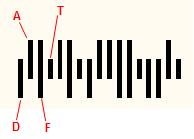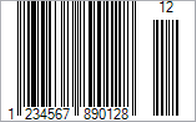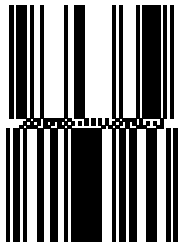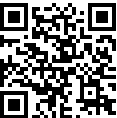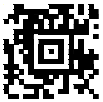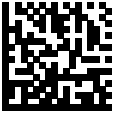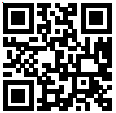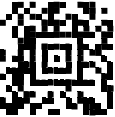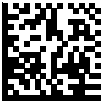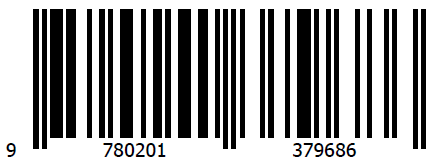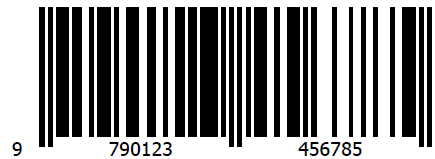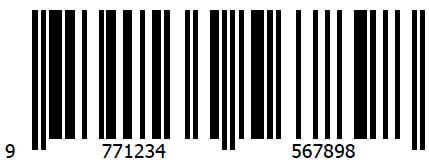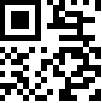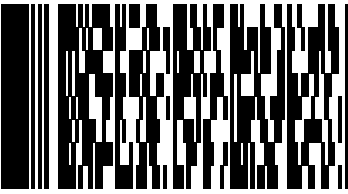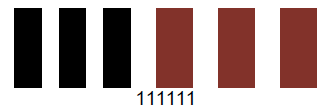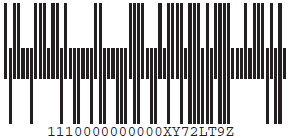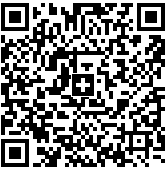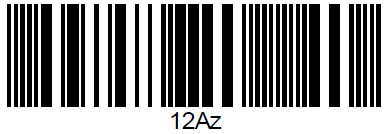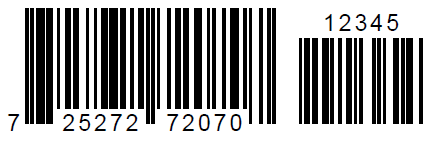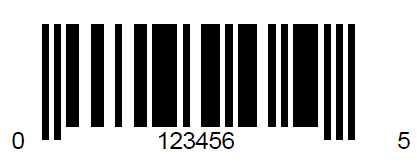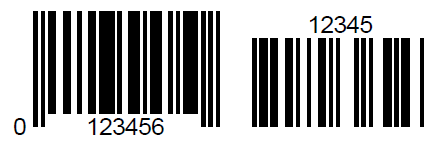Supported Barcodes and Matching QLingo Parameters
The following table summarizes the available barcodes supported by uPlan/uCreate, and their corresponding QLingo names. For more information, see http://www.tec-it.com/download/PDF/Barcode_Reference_EN.pdf
|
Barcode Symbology |
Name Parameter |
Description |
|---|---|---|
|
Australian Post Customer
|
AusPostCustom |
Used by the Australian Post for marking shipments. Special code variants are available for redirections, replies and so on. Due to its number of bars (37) Australian Post Customer is also called Australia Post 37-CUST. |
|
Australian Post Customer 2
|
AusPostCustom2 |
This is the same barcode as the Australian Post Standard Customer, but with additional 5 characters for customer specific data. The first 8 characters must be digits. This symbology is also called Australia Post 52-CUST (Due to its 52 bars). |
|
Australian Post Customer 3
|
AusPostCustom3 |
This is the same barcode as the Australian Post Standard Customer, but with additional 10 characters for customer specific data. The first 8 characters must be digits. This symbology is also called Australia Post 67-CUST (Due to its 67 bars). |
|
Australian Post Reply Paid
|
AusPostReplyPaid |
Used by the Australian Post for the Reply Paid service. |
|
Australian Post Routing
|
AusPostRouting |
Used by the Australian Post for the Routing service. |
|
Australian Post Redirection
|
AusPostRedirect |
Used by the Australian Post for the Redirection service. |
|
Aztec Code
|
AztecCode |
Can encode from small to large amounts of data with user-selected percentages of error correction. The symbol size adjusts automatically depending on the amount of input data. |
|
Brazilian CEPNet
|
CetNet |
Used by the Brazilian Postal Services. An 8 digit ZIP-code is encoded. The check digit is calculated automatically. It cannot be specified in the input data. The encoding is based on US Postal codes. |
|
CODABAR 2
|
CodaBar2 |
In 1977 the American Blood Commission defined Codabar 2 as standard symbology for blood banks (=ABC Codabar) |
|
CODABLOCK F
|
CODABLOCK_F |
Codablock F is de facto a “stacked” Code128 symbology. It is based upon Code 128 - each row is a single Code 128 symbol extended with row indicator information and additional check digits. The UCC/EAN/GS1 format indicator is supported. |
|
Code 2 of 5 Standard
|
Code2OF5 |
This is a self-checking code. It is used for industrial applications, article numbering, photo development, ticketing. |
|
Code 2 of 5 Interleaved
|
Code2OF5IL |
Widely used for article-numbering, industrial applications. This self-checking code offers high data capacity due to encoding pairs of numbers (the first digit is encoded in the bars, the second in the spaces). Thus, this symbology can encode only an even number of digits. If the number of digits is odd a leading zero will be inserted automatically. |
|
Code 2 of 5 IATA
|
Code2OF5IATA |
This is a self-checking code. Start/stop-characters are identical to Code 2 of 5 Industry. It supports distance reading (> 1m) and can be printed with very simple printing techniques. It is used for baggage handling in air-transport applications (International Air Transport Agency =IATA). |
|
Code 2 of 5 Matrix
|
Code2OF5M |
This is a self-checking code. It is used for industrial applications, article numbering, photo development, ticketing. |
|
Code 2 of 5 Data Logic
|
Code2OF5DL |
This symbology is proprietary variant of Code 2 of 5 Standard. |
|
Code 2 of 5 Industry
|
Code2OF5IND |
|
|
Code 11
|
Code11 |
Mainly used in telecommunications for marking equipment and components. |
|
Code 32
|
Code32 |
It is used by the Italian Pharma Industry. The code is also called Italian Pharmacode. The Code 32 number, consisting of 9 digits, is converted to an equivalent Code 39 Barcode of 6 characters. The letter the human readable text is prepended by “A” which is not encoded. |
|
Code 39
|
Code39 |
In heavy use in industry, organizations and commerce. Developed in 1974 by INTERMEC and got standardized by ANSI MH 10.8 M-1983 and MIL-STD-1189. |
|
Code 39 Full ASCII
|
Code39FA |
This barcode is rarely used because Code 128 offers much better compression. Uses uses the same symbology as Code 39 but encodes also lower-case letters and special characters („+A“ results in a lower case „a“ when scanned). Scanner must be configured correctly for decoding this barcode. |
|
Code 93
|
Code93 |
Code 93 was invented achieve better information densities (compared to Code 39). Code concatenation is possible (if the first encoded character is a space, subsequent barcodes are concatenated by the scanner). |
|
Code 93 Full ASCII |
Code93FA |
Based upon Code 93 but encodes the complete ASCII character set. One of the four available control characters is used to shift into the ASCII-character table. |
|
Code 128
|
Code128 |
Modern high-density symbology. Heavily used in all areas. Uses a built-in check digit (Modulo 103). This check digit is part of the code and cannot be omitted. It is never printed in the human readable text. Scanners are checking it when reading a code but do not deliver the check digit to connected systems. |
|
Code 128 Subset A
|
Code128A |
A variant of Code128 which uses character set (subset) A. It is suitable for encoding upper case characters + ASCII control sequences. It switches to other Code128 subsets when required. |
|
Code 128 Subset B
|
Code128B |
A variant of Code128 which uses character set (subset) B. It is suitable for encoding lower & upper case letters. It switches to other Code128 subsets when required. |
|
Code 128 Subset C
|
Code128C |
A variant of Code128 which uses character set (subset) C. It is suitable for encoding digits. It switches to other Code128 subsets when required. |
|
|
DAFT |
Description DAFT Code is not a symbology. It is a technique to generate arbitrary postal codes. It can be useful when postal barcodes exist as a DAFT stream instead of the original digit stream. DAFT streams are used by the Australian Postal code, USPS Intelligent Mail code and the Royal Mail 4-State code. A typical DAFT stream looks like this: AAFAAAFTFFAADTADTATTFADFFAFFAAATAFTTDDDAAADDADTAATTTTATFTDDDDFTDF Each input character stands for a specific bar type. There are 4 different bar types, as specified below. Characteristics The only valid characters are “DAFT” or “daft”. Each input character stands for a specific bar type:
By default, the DAFT method shows readable text, so use "HideReadableText=true" if needed. |
|
Usage: Use the DAFT code to overcome the issue of USPS Intelligent Mail Barcode accepting as input digits only. In order to encode the digits into the DAFT stream, you must use encoders for specific barcodes. Follow this procedure:
|
||
|
Data Matrix
|
DataMatrix |
Used for encoding large amounts of data and is also ideal for marking small objects. The symbol size adjusts automatically depending on the amount of input data. It is the de-facto standard symbology in the following areas:
|
|
Deutsche Post Leitcode
|
DPLeit |
This symbology is used by Deutsche Post. The code is basically a Code 2 of 5 Interleaved enhanced with a special check digit calculation. It is used for encoding the ZIP-Code, Street and number of the shipment. |
|
Deutsche Post Identcode
|
DPIdent |
This symbology is used by Deutsche Post. The code is basically a Code 2 of 5 interleaved enhanced with a special check digit calculation. |
|
DotCode
|
DotCode |
DotCode is 2 dimensional dot code symbology designed to be reliably readable when printed by high-speed inkjet or laser dot technologies. The encoding modes of DotCode are based on the Code128 data encoding (with modes A, B, and C) extended by a so called Binary Mode. The default interpretation for DotCode data is ECI 000003 representing the Latin-I character set. The DotCode symbology does not have absolute capacity limits, but a maximum symbol size of 124x124 dots is recommended. Note: DotCode is not supported in PDF format. |
|
DPD Code
|
DPD |
DPD Code is used by DPD (Deutscher Paket Dienst). It is based on Code 128 and is limited to 28 encoded characters. The encoded data and the human readable text differ slightly. |
|
EAN 8
|
EAN8 |
Creates an EAN8 encoding of the expression. |
|
EAN 8 with 2 Digits Add On
|
EAN8P2 |
Extends EAN-8 with 2 add-on digits which are mainly used for encoding the price or the weight. The check digit will be calculated automatically if it not specified in the input data. Also used for bar-coding paperbacks or newspapers. In this case a 2(3) digits country code and a 4(5) article code are encoded. |
|
EAN 8 with 5 Digits Add On
|
EAN8P5 |
Extends EAN-8 with 5 add-on digits which are mainly used for encoding the price or the weight. The check digit will be calculated automatically if it not specified in the input data. |
|
EAN 13
|
EAN13 |
Reserved for the European Article Numbering (EAN) system. Used for identifying articles or products uniquely. Encoded are a 2-digit country code, 5-digits manufacturer code and a 5 digits products code. |
|
EAN 13 with 2 Digits Add-On
|
EAN13P2 |
This symbology extends EAN-13 with 2 add-on digits. The check digit will be calculated automatically if it is not specified in the input data. |
|
EAN 13 with 5 Digits Add-On
|
EAN13P5 |
This symbology extends EAN-13 with 5 add-on digits. The check digit will be calculated automatically if it not specified in the input data. |
|
EAN-14
|
EAN14 |
EAN-14 is used to encode the GTIN (Global Trade Item Number) for numbering trade items. EAN-14 uses EAN-128 with Application identifier (AI) 01. The AI is prefixed automatically; it must not be part of the input data. The check digit is calculated automatically if not specified in the input data (that is when only 13 digits are used). |
|
EAN 128
|
|
Based upon Code-128. The same as the UCC-128 and the GS1-128. It has an FNC1 character at the 1st position (after the start code). This allows scanners and data processing software to differentiate EAN-128 from other symbologies. Widely used (retail, logistics, food and beverage, etc.). Besides the article-number it encodes quantities, weights, prices, dates, and other information in a structured way. |
|
Flattenmarken
|
Flattenmarken |
A special “barcode” used for recognizing the correct sequence of pages in print-shops. |
|
GS1 128
|
GS1_128 |
The GS1-128 is simply another name for the existing EAN-128 (or UCC-128) barcode. The EAN and UCC standardization organizations founded GS1 in order to globalize (and harmonize) their different standards. |
|
GS1 DataBar (RSS-14)
|
GS1DataBar |
GS1 DataBar is used to encode the GTIN (Global Trade Item Number) with Application identifier (AI) “01“. The GTIN consists of a packaging indicator (0..9) followed by a 12 digit number (taken from the EAN-13 article number system) followed by a check digit. The check digit on the 14th position is computed automatically if not provided in the input data. |
|
GS1 DataBar Limited
|
GS1DataBarLtd |
This symbology is similar to GS1 DataBar, but it is smaller in size and limited to a packaging indicator (first digit) 0 or 1. |
|
GS1 DataBar Expanded
|
GS1DataBarExp |
This is a variable length symbology. Data should be encoded with Application Identifiers (AIs). Omni-directional scanning is possible. |
|
GS1 DataBar Truncated
|
GS1DataBarTrunc |
This symbology is similar to GS1 DataBar but the height should be at least 13X. Omni-directional scanning may not be possible. |
|
GS1 DataBar Stacked
|
GS1DataBarStacked |
This symbology is similar to GS1 DataBar, but it is split into 2 rows to make the symbol smaller. It is used for pharmaceutical packaging. Omni-directional scanning is not possible. |
|
GS1 DataBar Stacked Omni-directional
|
GS1DataBarStackedOmni |
This symbology is similar to the GS1 DataBar Stacked and supports omni-directional scanning. |
|
GS1 DataBar Expanded Stacked |
GS1DataBarExpStacked |
This is the stacked version of GS1 DataBar Expanded. The number of data segments per row can vary between 4 and 22. The default number of data segments is 4. |
|
GS1 QR Code
|
GS1 QR Code |
GS1 QR Code is a variant of QR Code that conforms to GS1 specifications. It is a standardized two-dimensional barcode that was designed specifically for sharing extended packaging information, such as lot number, product ID, and quantity. GS1 QR Code can carry all GS1 keys and attributes. It can be applied to hold trade item information such as the item expiry date, serial number or batch/lot number. |
|
GS1 Data Matrix
|
GS1 DataMatrix |
GS1 DataMatrix is a variant of the Data Matrix symbology that conforms to GS1 specifications. GS1 DataMatrix is used in the aerospace, medical device manufacturing, and pharmaceutical industries, among others, and by the US Department of Defense. |
|
Han Xin Code
|
HanXinCode |
Han Xin Code is a 2D matrix symbology which is used for encoding large amounts of data and provides a special support for encoding Chinese characters (character set GB18030). |
|
HIBC LIC 128
|
HIBCLic128 |
A Health Industry barcode. LIC - Label Identification Code (LIC) is specified by the Supplier Labeling Standard. HIBC LIC 128 is based on the symbology Code 128. The data format corresponds to the HIBC LIC Format. An additional modulo 43 check digit is required. |
|
HIBC LIC 3 Of 9 (HIBC LIC 39) 
|
HIBCLic3Of9 |
A Health Industry barcode. LIC - Label Identification Code (LIC) is specified by the Supplier Labeling Standard. HIBC LIC 39 is based on the symbology Code 39. The data format corresponds to the HIBC LIC Format. An additional modulo 43 check digit is required. |
|
HIBC LIC Aztec Code
|
HIBCLICAztec |
A Health Industry barcode. LIC - Label Identification Code (LIC) is specified by the Supplier Labeling Standard. HIBC LIC Aztec Code is based on the 2D symbology Aztec Code. The data format corresponds to the HIBC LIC Format. An additional modulo-43 check digit is required. |
|
HIBC LIC Codablock F
|
HIBCLicCODABLOCK_F |
A Health Industry barcode. LIC - Label Identification Code (LIC) is specified by the Supplier Labeling Standard. HIBC LIC Codablock F is based on the stacked symbology Codablock F. The data format corresponds to the HIBC LIC Format. An additional modulo 43 check digit is required. |
|
HIBC LIC Data Matrix
|
HIBCLicDataMatrix |
A Health Industry barcode. LIC - Label Identification Code (LIC) is specified by the Supplier Labeling Standard. HIBC LIC Data Matrix is based on the 2D symbology Data Matrix. The data format corresponds to the HIBC LIC Format. An additional modulo 43 check digit is required. |
|
HIBC LIC MicroPDF417
|
HIBCLicMPDF417 |
A Health Industry barcode. LIC - Label Identification Code (LIC) is specified by the Supplier Labeling Standard. HIBC LIC MicroPDF417 is based on the 2D symbology MicroPDF417. The data format corresponds to the HIBC LIC Format. An additional modulo 43 check digit is required. |
|
HIBC LIC PDF417
|
HIBCLicPDF417 |
A Health Industry barcode. LIC - Label Identification Code (LIC) is specified by the Supplier Labeling Standard. HIBC LIC PDF417 is based on the 2D symbology PDF417. The data format corresponds to the HIBC LIC Format. An additional modulo 43 check digit is required. |
|
HIBC Lic QR Code
|
HIBCLicQRCode |
A Health Industry barcode. LIC - Label Identification Code (LIC) is specified by the Supplier Labeling Standard. HIBC LIC QR-Code is based on the 2D symbology QR-Code. The data format corresponds to the HIBC LIC Format. An additional modulo 43 check digit is required. |
|
HIBC Pas 128
|
HIBCPas128 |
A Health Industry Barcode. PAS - Provider Applications Standard (PAS). HIBC PAS 128 is based on the symbology Code 128. The data format corresponds to the HIBC PAS Format. An additional modulo 43 check digit is required. |
|
HIBC Pas 3 of 9 (HIBC Pas 39)
|
HIBCPas3OF9 |
A Health Industry Barcode. PAS - Provider Applications Standard (PAS). HIBC PAS 39 is based on the symbology Code 39. The data format corresponds to the HIBC PAS Format. An additional modulo 43 check digit is required. |
|
HIBC PAS Aztec Code
|
HIBCPASAztec |
A Health Industry Barcode. HIBC PAS Aztec Code bases on the 2D symbology Aztec Code. The data format corresponds to the HIBC PAS Format. An additional modulo-43 check digit is required. |
|
HIBC PAS Codablock F
|
HIBCPasCODABLOCK_F |
A Health Industry Barcode. PAS - Provider Applications Standard (PAS). HIBC PAS Codablock F is based on the stacked symbology Codablock F. The data format corresponds to the HIBC PAS Format. An additional modulo 43 check digit is required. |
|
HIBC Pas Data Matrix
|
HIBCPasData Matrix |
A Health Industry Barcode. PAS - Provider Applications Standard (PAS). HIBC PAS Data Matrix is based on the 2D symbology Data Matrix. The data format corresponds to the HIBC PAS Format. An additional modulo 43 check digit is required. |
|
HIBC PAS MicroPDF417
|
HIBCPasMPDF417 |
A Health Industry Barcode. PAS - Provider Applications Standard (PAS). HIBC PAS MicroPDF417 is based on the 2D symbology MicroPDF417. The data format corresponds to the HIBC PAS Format. An additional modulo 43 check digit is required. |
|
HIBC Pas PDF417
|
HIBCPasPDF417 |
A Health Industry Barcode. PAS - Provider Applications Standard (PAS). HIBC PAS PDF417 is based on the 2D symbology PDF417. The data format corresponds to the HIBC PAS Format. An additional modulo 43 check digit is required. |
|
HIBC Pas QR Code
|
HIBCPasQRCode |
A Health Industry Barcode. PAS - Provider Applications Standard (PAS). HIBC PAS QR-Code is based on the 2D symbology QR-Code. The data format corresponds to the HIBC PAS Format. An additional modulo 43 check digit is required. |
|
ISBN 13
|
ISBN13 |
ISBN is the abbreviation of International Standard Book Number. It uses the symbology EAN-13. When encoding ISBN in an EAN-13 barcode, the ISBN number is preceded by the number 978 and the ISBN check digit is not used. The customer must only enter 10 digits. ISBN codes with 10 digits are automatically converted to the newer ISBN with 13 digits. |
|
ISBN 13 with 5 Add-On Digits
|
ISBN13P5 |
Extension of the ISBN 13 with additional 5 digits. The add-on is used for additional pricing information. |
|
ISMN
|
ISMN |
ISMN stands for International Standard Music Number. The ISMN is a standardized international code, which identifies printed music. The ISMN is preceded by the digits 9790. The ISMN (=EAN-13) check digit is calculated and appended automatically! |
|
ISSN
|
ISSN |
ISSN stands for International Standard Serial Number. The ISSN is a standardized international code, which identifies any serial publication independently of its country of origin, its language or alphabet, or its frequency, medium, etc. The ISSN is preceded by the digits 977. The check digit of an 8-digit ISSN code (the last of the 8 digits) must be omitted! A two digit price code, almost always "00", is added to the end. Finally the EAN-13 check digit is added. |
|
ISSN with 2 Add-On Digits
|
ISSNP2 |
Extension of ISSN barcode symbology with 2 add-on digits. |
|
Italian Postal 2 of 5
|
ItalianPostal2Of5 |
Italian Postal Code 2 of 5 is based upon Code 2 of 5 Interleaved, but it is limited to 12 digits (11 usable digits + 1 modulo 10 check digit). |
|
ITF-14
|
ITF14 |
Encodes the GTIN-14, this is a 14-digit number used to identify trade items at various packaging levels (also referred as GTIN). ITF-14 is based on the Code 2 of 5 Interleaved symbology. It encodes 14 digits (13 usable digits + 1 modulo 10 check digit). The check digit method complies with the EAN-14 method. ITF-14 uses “Bearer Bars”, these are horizontal or surrounding bars, to prevent misreads. |
|
Japanese Postal Code
|
|
Used by the Japanese Postal system. You can encode 7 digits followed by block and street number (uppercase alphanumeric). The special compaction mode of Japanese characters can be enabled on demand. This barcode symbology supports two methods to provide the barcode data (with and without data extraction from the Japanese Address B Field). |
|
KIX - Dutch Postal Code
|
KIX |
This code is used by the Dutch Postal system. |
|
Korean Postal Authority
|
KoreanPostalAuth |
This code is used by the Korean Postal system. Encoded are a 6-digit ZIP and 1 check digit. |
|
LOGMARS
|
LOGMARS |
This is a special variant of Code 39 used by the U.S. Department of Defense. This standard defines acceptable ranges for a number of variables, include density, ratio, bar height, and size of the human-readable interpretation line. The modulo-43 check digit, which is optional for Code 39, is defined and recommended in the specification. |
|
MaxiCode
|
MaxiCode |
MaxiCode is in use (and was invented) by UPS®. MaxiCode represents data by drawing hexagonal items, which are arranged around a circular center (a so called "Bull's Eye"). Different encoding modes for including postal information (SCM) can be adjusted: UPS Modes are Mode 2 (US Carrier) and Mode 3 (International Carrier). |
|
MicroPDF417
|
MicroPDF |
Used to encode large quantities of data. |
|
Micro QR-Code
|
MicroQRCode |
This is small variant of QR-Code with a reduced number of overhead modules and a restricted range of sizes. The symbol size adjusts automatically depending on input data. Micro QR-Code has 4 different symbol sizes (M1-M4). The smallest version (=size) M1 is restricted to numeric data and error detection, M2 may contain also alphanumeric values, and M3 and M4 may use the whole range of the QR-Code character sets (bytes, Kanji). |
|
MSI (Modified Plessey)
|
MSI |
A variant of the Plessey-Code. |
|
National Trade Item Number (NTIN)
|
NTIN |
A Health Industry barcode. The content of the NTIN Code is specified by GS1. It was developed in order to get unique pharmaceutical product codes on an international level. It embeds the already existing national coding systems, like PZN in Germany. |
|
NVE 18 (Nummer der Versandeinheit)
|
NVE18 |
NVE stands for “Nummer der Versandeinheit” (a German term for tracking number). This code uses an EAN-128 symbology with a prefixed Application Identifier (AI) 00. The AI “00” is inserted automatically and must not be included in the input data. It is similar to SSCC-18. |
|
PDF417
|
PDF417 |
It is used to encode large quantities of data. It is the de-facto 2D standard symbology in the automotive industry. |
|
PDF417 Truncated
|
PDF417Trunc |
Used to encode large quantities of data. The symbol is divided into rows and columns. A data-density of up to 900 characters per square inch is possible. |
|
Pharmacode One-Track
|
Pharma1 |
Used in pharmaceutical areas. Pharmacode supports colored bars. The data for the bars/spaces is encoded directly in the property Text:
|
|
Pharmacode Two-Track
|
Pharma2 |
Pharmacode assigns numeric values to the bars. It is used for medicine packing in pharmaceutically area; for small labels. Usually Pharmacode is printed without a human readable text. |
|
Planet 12
|
Planet12 |
This code was developed for the United States Postal Services. It is a 3-of-5 variant of the Postnet barcode. |
|
Planet 14
|
Planet14 |
This code was developed for the United States Postal Services. It is a 3-of-5 variant of the Postnet barcode. |
|
PNZ7
|
PZN7 |
PNZ - Pharma Zentralnummer PZN uses Code 39 as the base symbology. It uses a special check digit and the human readable text always contains the prefix “PZN-“ (which is not encoded in the barcode data). PZN7 is valid until the end of 2012 and will be replaced by PZN8 with the beginning of year 2013. PZN7 numbers will stay valid but are going to be extended to 8 digits by a leading “0”. |
|
Plessey Code
|
Plessey |
Plessey code is in use primarily in libraries. It is a pulse-width modulated code and was developed by Plessey Company Limited in UK. The check digit is calculated with a polynomial CRC algorithm and is always part of the symbology. |
|
Plessey Bidirectional |
PlesseyBidir |
|
|
Pharmacy Product Number
|
PPN |
The Pharmacy Product Number (PPN) barcode is a variant of Data Matrix that is used for the distribution and marking of health care and pharmaceutical products worldwide. It was developed in accordance with the 2011/62/EU directive to harmonize the separate coding systems that the countries in the European Union use, and it also accommodates international code systems, such as the Global Trade Item Number (GTIN). |
|
PZN8
|
PZN8 |
PZN (Pharma-Zentral-Nummer) is a code for medicine identification in Germany. PZN uses Code 39 as the base symbology. It uses a special check digit and the human readable text always contains the prefix “PZN-“ (which is not encoded in the barcode data). PZN8 replaces the old PZN and offers a larger number range by the additional digit. |
|
QR-Code
|
QRCode |
Used to encode large quantities of data and was developed for fast readability (QR = Quick Response Code) by Denso. The symbol size adjusts automatically depending on input data. Special industry formats are supported. |
|
Royal Mail 4 State
|
RM4SCC |
This code is a height modulated code using 4 different vertical bars. It is used in mass-mailing applications (Cleanmail, Mailsort) of the Royal Mail, United Kingdom and Singapore (also called SinPost barcode). Encoded are ZIPs. |
|
Royal Mail 2D CMDM Mailmark
|
CMDM_Mailmark |
A Complex Mail Data Mark (CMDM) is a 2 Dimensional barcode that has the specified format of a Data Matrix type ECC200 code complying with the international standard ISO/IEC 16022, version 2006. XMPie supports Formats 7, 9 and 29 of the CMDM Mailmark™ barcode:
|
|
Royal Mail Mailmark 4-state
|
4state_Mailmark |
This code is a height-modulated code using four different vertical bars. It is defined and used by the Royal Mail for postal services. The following variants of Mailmark 4-state are used:
Each field within any Mailmark 4-state is of a fixed and defined length. The length in total must be either 22 (for variant C) or 26 characters (for variant L). Missing or optional attributes must be filled with the space character. |
|
SSCC-18
|
SSCC18 |
SSCC-18 is used for encoding the Serial Shipping Container Code. It is used for the unique identification of trade items world-wide. SSCC-18 is based on the EAN-128 symbology with Application Identifier (AI) 00. The check digit is encoded automatically if 17 digits are used for the input data. |
|
Swedish Postal Shipment Item ID
|
SwedishPostal |
This Code is based upon Code 128 and is used on Swedish Postal labels. The check digit is calculated according to weighted modulo 11 method for Universal Postal Union (for 8 digits). |
|
Swiss QR Code
|
Swiss QR Code |
The Swiss QR Code is part of the so-called QR-Rechnung, defined by SIX Interbank Clearing AG. It contains the needed information to initiate customer credit transfers via barcode scanner. The Swiss QR Code is based on the QR Code symbology, extended with a black Swiss Cross drawn in the center of the code. |
|
Telepen
|
Telepen |
Telepen can encode pairs of characters only. A pair must consist of 2 digits or of one digit and the letter ‘X’. |
|
Telepen Alpha
|
TelepenAlpha |
Telepen Alpha is the alphanumeric variant of Telepen. |
|
UCC 128
|
UCC128 |
Same as the EAN-128. |
|
UPC-A
|
UPCA |
UPC A is used for article bar-coding. It is used in the United States for marking of products in retail applications (similar to EAN). |
|
UPC-A with 2 Add-On Digits
|
UPCAP2 |
Identical to UPC-A, but with 2 add-on digits. The check digit will be calculated automatically if it is not specified in the input data. The check digit is not displayed in the human readable text. |
|
UPC-A with 5 Add-On Digits
|
UPCAP5 |
Identical to UPC-A, but with 2 add-on digits. The check digit will be calculated automatically if it is not specified in the input data. The check digit is not displayed in the human readable text. |
|
UPC 12
|
UPC12 |
The symbologies UPC-A and UPC-12 are identical. The check digit is calculated automatically if not specified in the input data (that is when only 11 digits are used for creating the code). |
|
UPC-E
|
UPCE |
UPC-E is used for product marking and article bar-coding. |
|
UPC-E with 2 Add-On Digits
|
UPCEP2 |
Identical to UPC Version E, but with 2 add-on digits. The check digit will be calculated automatically if not specified in the input data. The check digit is not displayed in the human readable text. |
|
UPC-E with 5 Add-On Digits
|
UPCEP5 |
Identical to UPC Version E, but with 5 add-on digits. The check digit will be calculated automatically if not specified in the input data.The check digit is not displayed in the human readable text. |
|
UPU S10
|
UPU_S10 |
This Code is based upon Code 128 and is used on Postal labels in various countries. The code consists of:
The check digit is calculated as follows: Assign the weights 8, 6, 4, 2, 3, 5, 9, 7 to the 8 digits, from left to right. Calculate S, the sum of each digit multiplied by its weight. For example, for the number 47312482, S = 4*8 + 7*6 + 3*4 + 1*2 + 2*3 + 4*5 + 8*9 + 2*7 = 200 Calculate the check digit, C, from C = 11 - (S mod 11) If C = 10, change to C = 0 If C = 11, change to C = 5 For the example 47312482 C = 11 - (200 mod 11) = 11 - 2 = 9. |
|
USPS Intelligent Mail
|
USPSIntelligentMail |
This symbology is also known as:
The following data is encoded:
Note: If you want to encode this barcode, use the Daft code. |
|
USPS Intelligent Mail Package Barcode
|
USPSIMPackage |
The barcode data consists of Routing information and Tracking information. The Routing information is optional. It is not printed in the human visible text and consists of:
The Tracking information is mandatory. It is printed in the human readable text and consists of 3 types of tracking information:
If you wish to include the Routing information, you must use the parameter “EscapeSequences=true”. The stream itself consists of both sub-streams (8 or 12 digits for the Routing information and 22 to 26 digits for the Tracking information). The two sub-streams should be separated by the \F symbol. In QLingo, this symbol should include two backslashes \\F; e.g. “420123456789\\F9212391234567812345670” The last digit is checksum modulo 10 of all the digits after F. |
|
USPS PostNet 5
|
USPSPostNet5 |
Used by the United States Postal Services for mass-mailing applications. It encodes Encoded a 5 digit ZIP-code. The check digit is calculated automatically. It cannot be specified in the input data. |
|
USPS PostNet 6
|
USPSPostNet6 |
Identical to USPS Postnet 5, but the check digit can be specified freely (the 6th digit). To be used only if the (correctly calculated) check digit is already part of the input data. |
|
USPS PostNet 9
|
USPSPostNet9 |
Used by the United States Postal Services for mass-mailing applications. Encoded are a 5 digit ZIP-code and 4 additional digits. The check digit is computed automatically, it cannot be specified in the input data. |
|
USPS PostNet 10
|
USPSPostNet10 |
Same as Postnet 9, but the check digit can be specified freely (the 10th digit). To be used only if the (correctly calculated) check digit is already part of the input data. |
|
USPS PostNet 11
|
USPSPostNet11 |
Used by the United States Postal Services for mass-mailing applications. Encoded are a 5 digit ZIP-code and 4 to 9 additional digits. The check digit is calculated automatically. It cannot be specified in the input data. |
|
USPS PostNet 12
|
USPSPostNet12 |
Same as Postnet 11, but the check digit can be specified freely (the 12th digit). To be used only if the (correctly calculated) check digit is already part of the input data. |
|
VIN Code
|
VIN |
Used for vehicle identification. It is based on Code 39, but does not contain start and stop characters. VIN Code is implemented differently in Europe and North America. Both kinds are compatible but the North American version is defined more strictly. So the check digit calculation method is only valid for the North American implementation of the code. |

















